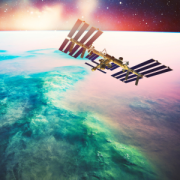Generative AI (GenAI) is set to have a profound effect on space exploration. Especially promising is the recent development of large language model (LLM)-based GenAI applications designed for use on spacecraft.
The deployment of GenAI in space is a significant advancement for mission-critical space technologies. In effect, these advanced AI edge computing applications are built specifically to run on high-performance computers optimized to operate on space stations and satellites. Consequently, they offer several key benefits, including:
-
Natural language processing (NLP). Astronauts can use intuitive and user-friendly natural language–based interfaces to access and analyze data generated by space operations and experiments conducted in space.
-
Reduced data transfer/latency issues. Instead of needing to first transmit raw data from spacecraft to Earth-based mission control for analysis, initial processing and analysis are performed on board, requiring only the results to be transmitted to ground-based stations.
-
Real-time decision-making. Astronauts have more timely access to findings from experiments and other analyses conducted on board. Similarly, Earth-based stakeholders are afforded faster access to satellite sensor data analyses and other findings. This capability is crucial during emergencies or time-sensitive situations (e.g., disaster planning, emergency services response).
-
Adaptive models. LLMs can be updated and uploaded to spacecraft so the models reflect changing conditions and work requirements.
LLMs on the International Space Station
Booz Allen Hamilton has deployed an LLM on the International Space Station (ISS). The application, operational since mid-July, is part of an experiment to test the feasibility of utilizing GenAI applications in the resource-constrained computing environment of a spacecraft. This, to the best of my knowledge, is the first LLM actually deployed in space.
Booz Allen, in collaboration with Hewlett Packard Enterprise (HPE), developed the application over a period of eight weeks. It was successfully uploaded to the ISS as part of a proof-of-concept (POC) experiment intended to assist astronauts with conducting laboratory experiments with GenAI without needing to rely on Earth-bound Internet. Primary functionality includes providing remote data ingestion and retrieval-augmented generation (RAG) to allow astronauts to effectively access information and accurately interpret and solve complex issues using natural language queries. (RAG is an architecture that enhances the capabilities of GenAI models, basically enabling them to access external information, thereby improving the accuracy and contextuality of their responses.)
Onboard Processing
The GenAI application runs on HPE’s Spaceborne Computer-2 (SBC-2) deployed on the ISS. It is designed to provide onboard, data center–level processing in space. Although consisting of commercial off-the-shelf technology, the components have been hardened to withstand the harsh conditions of outer space.
SBC-2 can ingest and process data from various sources, including satellites, cameras, and other sensor systems, in real time and can simulate computational loads associated with space travel. It can also handle the complex, compute-intensive AI and machine learning workloads associated with the research and analytical experiments conducted on the ISS, including for healthcare, image processing, disaster recovery, 3D printing, and natural NLP.
In summary, SBC-2 enhances onboard computing, leading to more efficient data handling, Earth-bound transmission, and enhanced decision-making. It is hoped that the deployment of Booz Allen Hamilton’s POC application on the SBC-2 platform will lead to a better understanding of the possibilities of deploying GenAI within in-space environments and that it can be scaled to support future use cases.
European Space Agency’s Φsat-2
The European Space Agency’s (ESA) Φsat-2 is a miniature satellite (“CubeSat”) designed to demonstrate how AI technologies can optimize Earth observation (EO) from space.
Φsat-2 will carry six AI applications. These include multi-spectral imaging tools and systems designed to eliminate images that are cloudy, detect and classify maritime vessels, transform images from one form to another for real-time map generation, spot anomalies in marine ecosystems, and detect wildfires. Φsat-2 also includes tools for compressing images on board and reconstructing them on the ground to reduce data-download requirements.
Of particular interest is the Sat2Map App, which utilizes Cycle-Consistent Adversarial Networks (CycleGAN) to transform satellite images into street maps, enabling the generation and delivery of near-real-time mapping data. CycleGAN is a form of GenAI that falls under the category of unsupervised image-to-image translation models. By learning mappings between two domains, CycleGAN facilitates creative transformations across different image styles or domains. Basically, image-to-image translation involves transforming an input image from one domain (e.g., photos) to an output image in another domain (e.g., a painting or, in this case, a map). This real-time mapping capability is deemed especially important for emergency services (e.g., enabling first responders to quickly identify still-accessible roads during disasters like earthquakes or floods).
According to ESA, Sat2Map will function as follows. When the Φsat-2 satellite orbits over an affected area and snaps images, they are processed by an onboard computer to identify streets and generate a corresponding map. ESA plans to initially test the Sat2Map App over Southeast Asia to demonstrate its potential to aid in crisis management.
The Φsat-2 project is a collaboration between the ESA and a consortium led by Open Cosmos consisting of Ubotica, CGI, CEiiA, GEO-K, KP Labs, and SIMERA.
Conclusion
GenAI looks promising for providing advanced AI edge computing capabilities in the realm of space. Although still in experimental stages, the Booz Allen Hamilton and ESA applications seek to demonstrate the possibilities of integrating GenAI capabilities directly on spacecraft by facilitating natural language–based data retrieval and analysis, improved data transmission efficiency, and real-time decision-making.
For more on the use of various AI technologies, including GenAI, for space applications, please see my Amplify Executive Update “Accelerating Space Exploration: The Confluence of Tech & Commercialization” and the full Amplify issue “Beyond Orbiting: Toward a Sustainable Space Economy.”
Finally, I’d like to get your opinion on the application of GenAI for space exploration. As always, your comments will be held in strict confidence. You can email me at experts@cutter.com or call +1 510 356 7299 with your comments.



